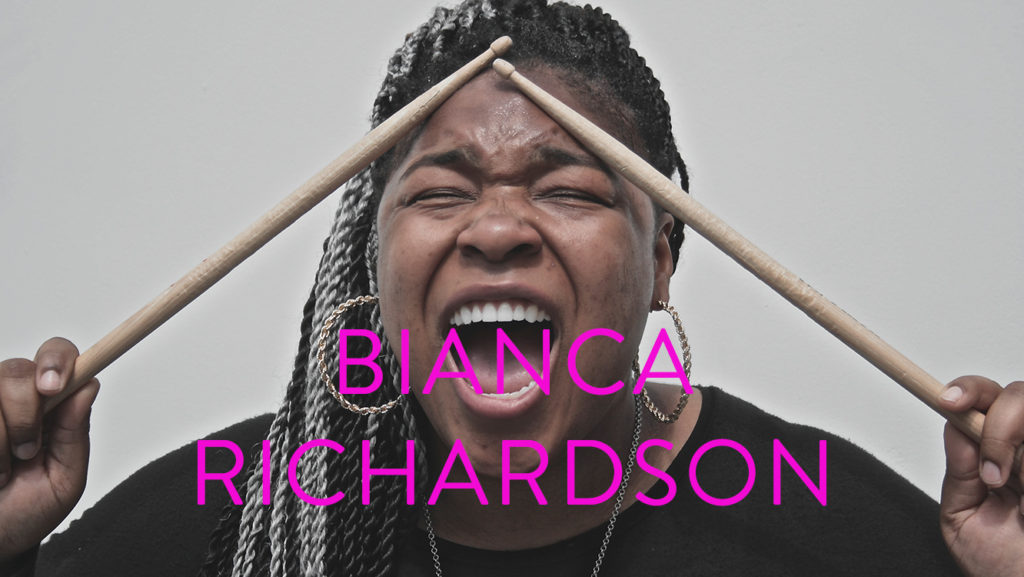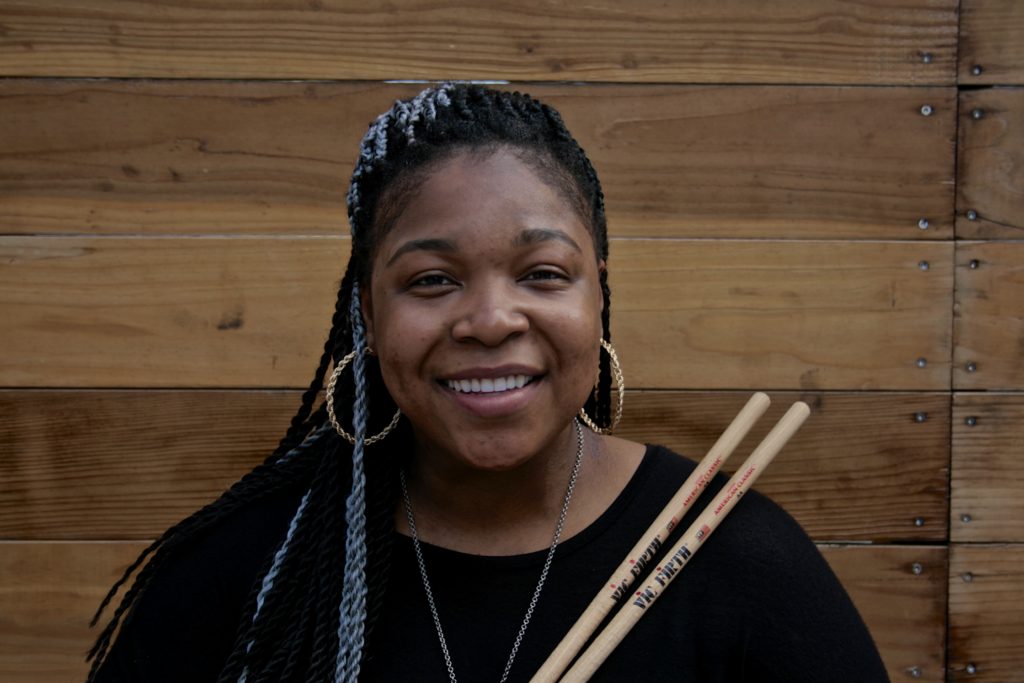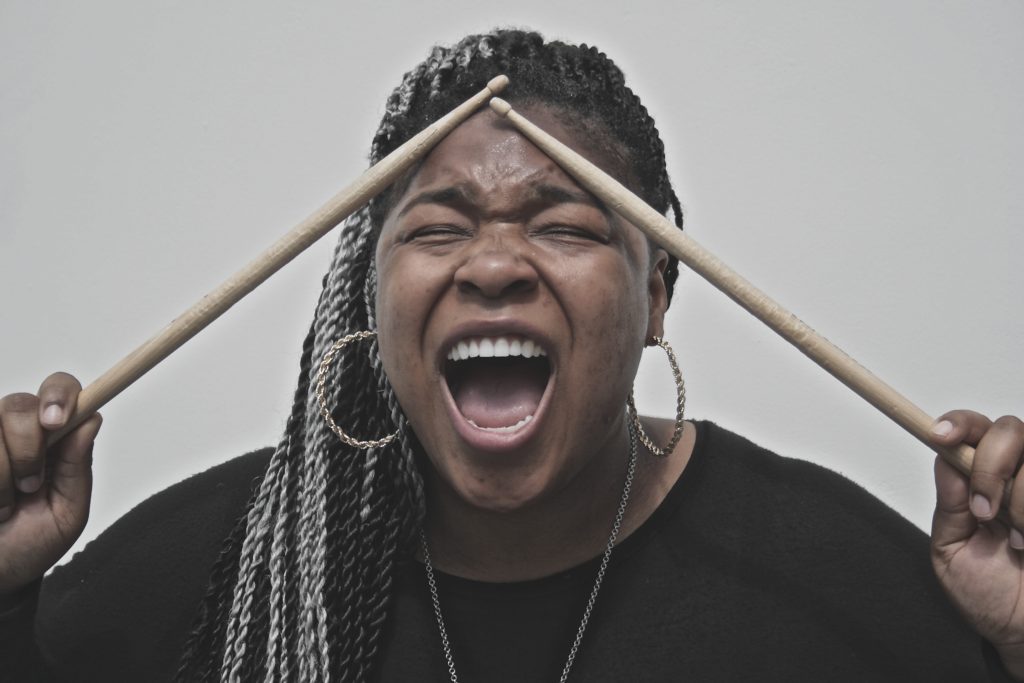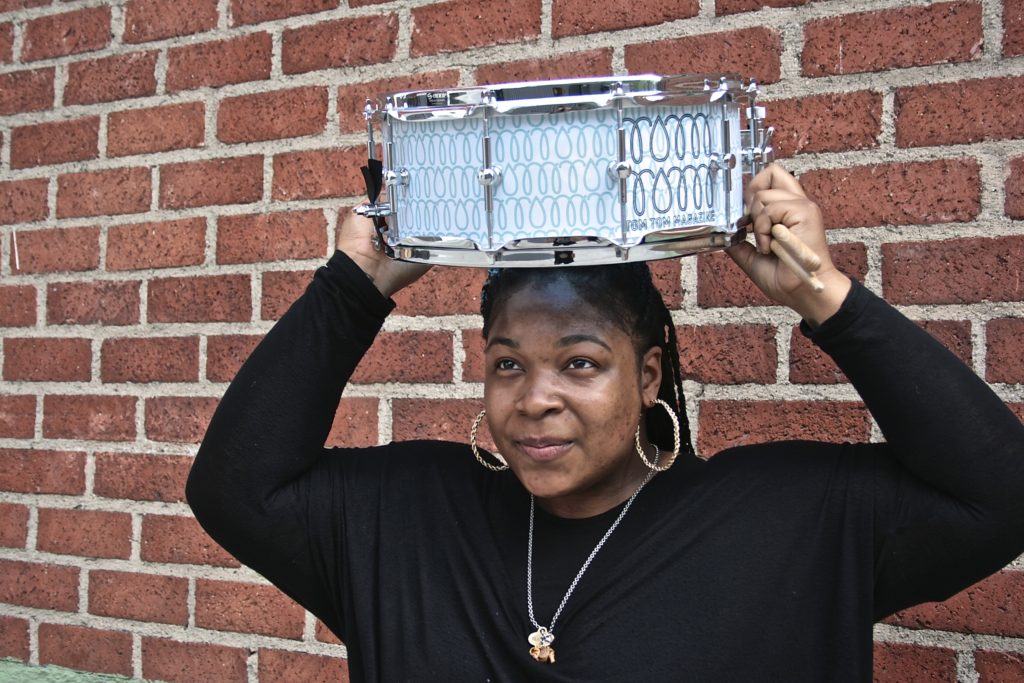
By Constance H. Lin
I sat down with Bianca Richardson, a full-time student who hails from Orange County and is currently studying at Musicians Institute (MI) in Los Angeles, CA. Bianca had just recently placed as second runner-up in the Hit Like A Girl contest, an international drum competition for female drummers.
CH: Can you tell me when you started playing?
BR: I started playing in junior high and, um, actually, it was a weird story. I started in junior high in the marching band, and then before I always wanted to play drums. I always admired the drumline. I remember I asked my band teacher, “can I join the drumline?” And he told me no! And the instrument he gave me was the trombone. He said he didn’t think being in the drumline was fit for a lady. That was a huge commotion I had to go through. I got my parents involved, I got the principle involved, and soon enough they put me on the line. But it shouldn’t have to be like that because it’s discrimination against women, you know? So that’s basically how I started. With the drum set, I didn’t start playing, because drumline and drum set, even though they’re both drums, they’re totally different things. When you’re in the drumline, you’re not doing anything with your feet. With the drum set, you’re incorporating all your limbs, all your hands and feet. So I didn’t play drum set until I was out of high school, which was 18, when I actually started studying full on.
CH: Did you study with a private teacher?
BR: No, I didn’t have a private teacher until 21. And my first teacher was Peter Buck. He was a jazz teacher. That’s where I really shot off my career with drum set. I started studying jazz, but then I realized jazz isn’t the style for me. It’s not the style I want to progress in. Jazz is definitely a genre to learn because that’s going to get your hands and feet going, but what I want to do is an R&B gig. The perfect example is Beyoncé, like that is my—I’m claiming that gig! I want that gig!
“It’s just very powerful to see a woman playing an instrument and playing it well.”
CH: Music is a very male-dominated industry. Clearly you’ve seen discrimination already as a young drummer in the past, but do you still see any of it now? Do you find that there is an imbalance in the opportunity to get gigs?
BR: Not so much anymore. It’s been sort of like a plus [to be a woman drummer] for me, but even though knowing that it’s a plus, I still want the truth—meaning I would rather go to audition where they hear me play first. And when they see me I want them to be like, “dang, she’s a girl!”

CH: Something like The Voice? [laughs]
BR: Yeah, something like that! Yeah, so, I don’t see as much of it now. But when I was little, like in junior high, it was definitely more [noticeable], because there weren’t many female drummers back in 2005, but now it’s definitely helping me out by being a girl, like getting gigs.
CH: How do you mean by helping you out?
BR: Okay, so if there’s an audition, and we’re both [musicians] at the same levels and have the same talent, it’s always a plus being a girl. Why? I guess it’s just being a musician—the music realm is very male-dominated. So that’s just how it is. It’s just very powerful to see a woman playing an instrument and playing it well.
CH: It’s really good to see another woman musician finding empowerment in their craft. Now let’s go back in time a little bit. You said you’re from Cypress?
BR: Yes! Cypress represent! [laughs].
CH: Any past bands that you were a part of?
BR: At Cypress College I started studying jazz. I did the vocal jazz program and that was very, very challenging for me because jazz is a different approach to a way of thinking in how to be more dynamic. Because rock and funk is very heavy on your foot. With jazz you have to learn how to be more sensitive with your hands with the cymbals and such. So that was a challenge for me. I did that for two years. Let’s see, I also played for Cottonwood Church. And I transferred [from Cypress College] to Fullerton College where I was in the jazz bands as well, and now I’m a full-time student at MI.
CH: Any female drummers that you draw inspiration from?
BR: Oh… Cora [Coleman] Dunham and Sheila E.! Reason why I like [Cora] is that her genre is jazz and fusion. Sheila E. is definitely latin. She’s more of a percussionist, but latin’s her thing. And she sings! Let’s see, I get a lot of my inspiration off Instagram videos. Like you can learn a lot within those little 15 second clips! But, I can tell you three other guy drummers. The three top drummers I’m definitely in love with is Chris Coleman, Gordon Campbell, and Chris Dave.

CH: You said you started out with jazz. Is there another genre you’re moving into now?
BR: Oh, definitely. Gospel and fusion. That’s always been my underlying thing. Jazz isn’t my thing, I just happened to study it.
CH: How do you define fusion, since there’s a couple of ways to look at it?
BR: Well, I think the reason why the genre’s called fusion is because it’s just a mixture of all the genres together. So, a fusion artist I can name is Steve Gadd, so that’s kind of like my direction.
CH: Earlier before we started, you mentioned something with T-Pain. Do you want to expand on that?
BR: [laughs] Okay so, that was really random. I saw an ad here, and it was some ad that said audition here, call this number. So I said, whatever, I’ll call. We met at Amp Studios, which is a pretty well-known place where artists rehearse. I got there, I played one song, and that was it. [laughs] And I got the gig! He didn’t tell me we were opening up for T-Pain. So the first rehearsal I went, he had two drummers. It was just a really big band. Two drummers, two guitarists, two keyboardists, just two of everything! A week before the T-Pain gig, the guy was just like, “oh hey, just letting you know, we’re opening for T-Pain.” So we weren’t on tour, but T-Pain just happened to be on tour and needed a band. It sucks that I didn’t get to meet him! It was like two in the morning and T-Pain hadn’t even gone on stage yet, so I went home. [laughs]
CH: Any more cool gigs coming up?
BR: The Nick Walker project, and I have two more projects coming. The school is going to help out one. We’re going to do Love On Top by Beyoncé and we’re having a full on band—horns, you’re normal set of drums, bass, guitar, two keyboardists, three background vocalists and the lead singer. That’s going to be really cool because the people that are in the band were already really good friends so it’s really cool to collab with fam and stuff.
CH: Can you tell me more about the Nick Walker project?
BR: We just got finished recording an EP of 5 songs at Jazzcats Studio. He has a website—nickwalkermusic.com and there’s one song on there that you can check out.
CH: So when’s the release date?
BR: Well, we’re still mixing so the date is still coming.
CH: Any shows coming up?
BR: We finished part one [of the EP] which is five songs, and we have another five songs [for part two of the EP] that we’re going to record next month. Our focus now is to get that done.
CH: It sounds like you have a lot of things in the works! Okay, last one, any other instruments that you play, or want to play?
BR: Okay, so I do play bass.
CH: Electric or upright?
BR: Electric. Upright is too confusing. [laughs] Um, keys.
CH: Synths or piano?
BR: Synths, yeah. I just learned those two because I want to–well, I am arranging stuff, because that’s the first thing I hear [in songs]. And I’m able to hear out chords and lines and stuff, so I just wanted to study it.
One photoshoot later, Bianca and I started talking about her unique snare drum. Her snare is a custom drum made by Salt Drums, an independent drum manufacturer located in Southern California. Bianca was initially attracted to the aesthetics of the drum, but shortly after she came to love its wide tonal range, the high quality materials crafted from it, and the exceptional care put into its creation. Bianca’s snare, now affectionately named the TomTom Exclusive Snare, is available for purchase via tomtommag.com.

Catch Bianca Richardson on Instagram @b.richdrumz and Salt Drums @saltdrums

